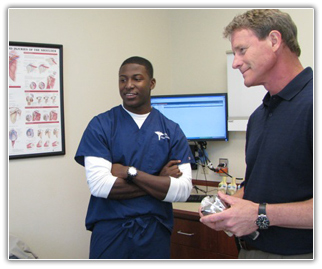Huntsville Orthopedic surgeon, Dr. Eric Janssen has a strong track record with knee surgery, from the most common procedures to state-of-the-art procedures that few orthopedists in our area perform.
 Dr. Janssen can help you with ACL injuries, meniscus injuries, osteoarthritis of the knee and most other knee problems. He performs these and other procedures for the knee:
Dr. Janssen can help you with ACL injuries, meniscus injuries, osteoarthritis of the knee and most other knee problems. He performs these and other procedures for the knee:
- ACL reconstruction, including the newest anatomic ACL reconstruction that recreates the natural movement of the knee better than older techniques. To watch Dr. Janssen perform an ACL Reconstruction, click on this link.
- Meniscus surgery – See Dr. Janssen discuss options for meniscus surgery, here.
- Total and partial knee replacement that gives you maximum results in terms of stability, function and pain relief, with the quickest possible recovery
- Cartilage repair and transplantation
- All types of arthroscopic knee surgery
Schedule an appointment for an evaluation or a second opinion and find out what treatment options are right for you. Janssen Orthopedics treats these and other knee conditions:
Osteoarthritis
According to the American Academy of Orthopaedic Surgeons, osteoarthritis of the knee – or “knee OA” – is one of the top five causes of disability among older men and women. This painful condition develops when protective cartilage in the knee deteriorates – aging, past knee injuries, or being overweight can all be factors in developing knee OA. As the knee loses cartilage, the surrounding bones become thicker and eventually create a deformity in the knee joint.
It’s important to seek the care of an experienced orthopedic specialist at the first sign of knee problems that could indicate knee OA, like swelling, stiffness or a feeling of weakness in the knee. Left untreated, the pain and disability of knee OA can make walking, work and everyday activities difficult or impossible. The good news is, with specialized care, you can manage knee OA and minimize its impact on your quality of life. To watch Dr. Janssen demonstrate a Total Knee Replacement, click here.
Anterior cruciate ligament (ACL) tear
Most people who get an anterior cruciate ligament (ACL) tear know something is wrong with their knee right away. Immediately after the injury, there is usually pain, swelling and a feeling of instability. This develops into major swelling, reduced range of motion and pain with walking.
Anyone can injure or tear the ACL – it’s the most commonly injured ligament in the knee – but most injuries are sustained during sports. It may be caused by contact with an object or another player (in football or soccer, for instance) or happen when a player pivots, sidesteps or makes an awkward movement in basketball, baseball / softball or any other physical activity. Here you can watch Dr. Janssen perform an exam on a soccer player with a suspected ACL tear.
Meniscus tear
The meniscus is a piece of tough, C-shaped cartilage that cushions and stabilizes the knee joint. Injuries to the meniscus often happen with twisting motions. Sudden meniscal injuries often occur during sports. In older people, the meniscus can become weaker and thin and vulnerable to injury.
With a sudden meniscus tear, you might feel a popping sensation, followed by stiffness and swelling. Other common symptoms include feeling as if the knee is catching, locking or giving way.
The severity and exact location of the injury determines treatment. Some meniscus injuries respond to conservative treatment – including rest, medication and physical therapy – to control symptoms and strengthen and stabilize the knee. Sometimes, surgery to repair the meniscus is necessary.
Combined knee ligament injuries
There are four main ligaments that hold the bones of the knee together and keep them stable. The collateral ligaments on the sides of the knee control the sideway movements of the knee. The cruciate ligaments form an “X” across the knee on the front and back and control back and forth movement. Any of these ligaments can be easily sprained or partially or completely torn during sports, on the job or as a result of other trauma.
When two or more of these ligaments are injured at the same time, it is referred to as a multiple or combined ligament injury – an often serious, complex knee problem. Injuries like these demand the care of an orthopedic specialist with experience in the various reconstructive techniques necessary for successful treatment. If you’ve been diagnosed with a combined ligament injury, or have recently been injured, talk with Dr. Janssen. He will perform a thorough exam and explain your condition and the treatment you’ll need to recover.
Kneecap pain & injury
There are several problems that can cause kneecap (patella) pain. These can be caused by sports injuries, chronic conditions like arthritis of the kneecap, or other traumatic injuries. Some of the more common kneecap conditions include:
- Runner’s knee (chondromalacia patellae) is basically irritation of the cartilage beneath the kneecap. Of course, it affects runners, but anyone who is active in sports or day-to-day life can experience this condition. It’s often seen in young, otherwise healthy people.
- If you’re a gardener and spend time kneeling, or if you have a job like carpet laying, you may be affected by a kneecap condition called prepatellar bursitis.
- Patellar subluxation, or unstable kneecap, occurs when the kneecap moves out of its normal groove in the knee. This painful condition may lead to kneecap dislocation.
Many kneecap problems can be successfully treated with nonsurgical treatments. It’s important to seek the care of a qualified specialist who has specific experience with kneecap injuries.

